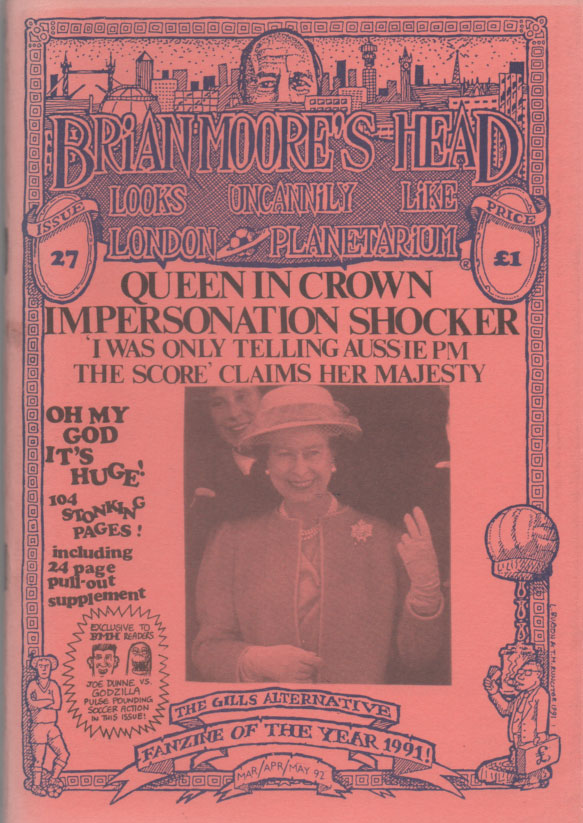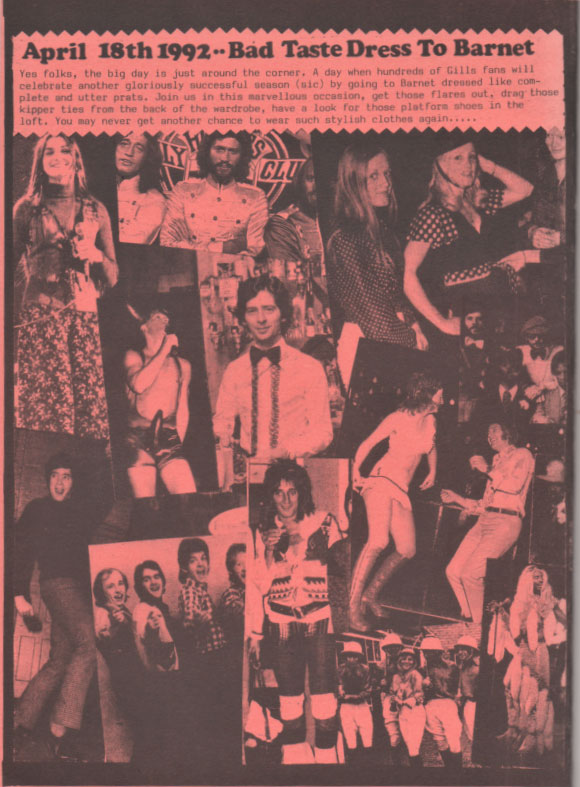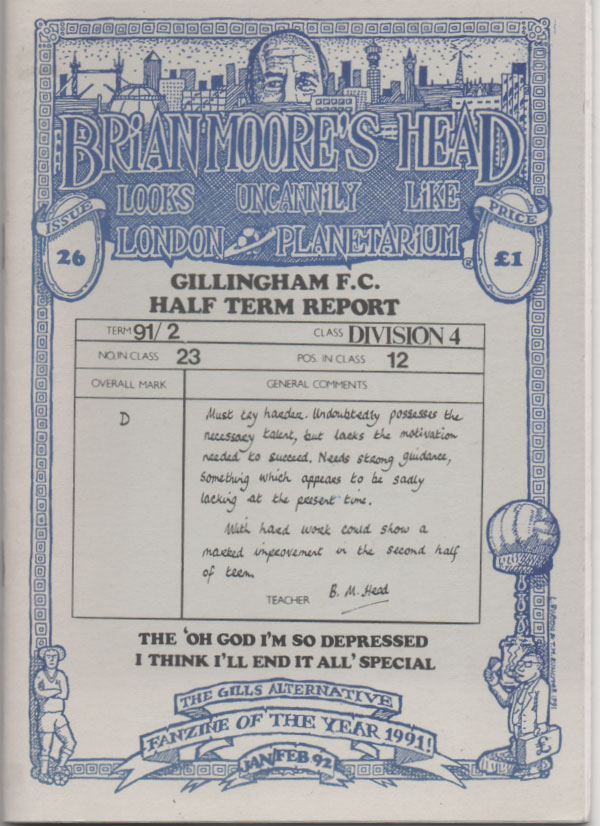Our fanzine series goes on...
On New Year’s Day 1992, prior to the home match against Hereford, the last copy of BMH3 was sold. Originally published in 1988, it had been a real struggle to sell out of this edition.
When BMH23, dated October 1991, had gone on sale, number three was the only one out of the first eleven still available as a back issue, ‘last few stragglers and real value for money at only 40p.’ BMH24 advised that ‘we only had three left at the last count, so chances to own this much-sought after item are fast disappearing’, with ‘Now I know you’re not going to believe this, but we’ve only got one (yes, one!) issue 3 left’ appearing in BMH25. I think it was more through sympathy that one of my friends finally bought the last copy.
On the following day, I took a box of the current issue, number twenty-five, up to our London outlet, Sportspages bookshop in Charing Cross Road. The shop still had a lot of unsold copies of the previous edition. It wasn’t a case of the popularity of the fanzine waning, but the fact that, in the run-up to Christmas, Sportspages had removed all such publications from sale, stating shortage of space, in order to promote books, a practice they adopted annually and one that left a bitter taste in the mouth, seeing as it was the fanzines that attracted the bulk of their customers.
After seven issues per season between 1988 and 1991, only six editions of the Head were produced during the 1991-2 campaign. This was due to the bad weather that caused the postponement of the home game against Rochdale on Saturday 25 January 1992, the day on which BMH26 was due to be launched. The knock-on effect of the delay of the issue going on sale meant that it wasn’t feasible to produce two further instalments. BMH26 was the ‘Oh God, I’m so depressed I think I’ll end it all special’, the cover featuring a mock half-term school report on Gillingham’s 91-2 campaign, with an overall ‘D’ grade and general comments, ‘Must try harder. Undoubtedly possesses the necessary talent, but lacks the motivation needed to succeed. Needs strong guidance, something which appears to be lacking at the present time. With hard work, could show a marked improvement in the second half of term.’
The editorial suggested that it was time for a change of manager, ‘The time has now surely come for Damien Richardson to step down. There is a right time and place for all managers. In 1989 Damien was the right man in the right place. He stopped the rot that threatened to carry us all the way to the Conference. With a squad of inexperienced youngsters, and no money to spend on new recruits, he did a great job of instilling a new sense of belief in both the players and supporters. Right up to the beginning of this season we had a team that was moving forward, improving to the point where we could once again take our rightful place in the Third Division. We are no longer moving forward, the club is beginning to stagnate in the middle of the Fourth Division. Damien Richardson is no longer the right man in the right place.’
BMH believed that the manager had lost the respect of the players and a large proportion of the fans and was unable to motivate the team, the editorial going on to mention that many supporters were ‘torn between liking Damien as a person and a desire to see the club be successful. No-one hates Damien and, deep down, no-one wants him to be sacked, but the team has to come first.’ The Head’s preferred method for change was for Damien to resign or be given another job within the club, ‘to spare himself the ignominy of being shown the door.’

With events at Gillingham bad enough, BMH were further dismayed by the increasingly erratic and inconsistent displays by their favourite referee Kelvin Morton, duly reported in BMH26. One of the editorial team had gone to Brisbane Road in December 1991 for Leyton Orient’s FA Cup tie against West Bromwich Albion. With the game being shown live on Sky, Morton had every opportunity to showcase his own unique refereeing masterclass to a bigger audience than usual, but he failed to take the chance, ‘He’d sent no-one off, booked not one player and hadn’t even given one single, measly penalty. He’d had a really good game and been in total control throughout. I left the ground with some of my illusions shattered. Kelvin competent? – surely not.’
However, there was an Oldham player who, after his side’s 4-2 defeat at Chelsea, wasn’t totally enamoured with our favourite official, with one newspaper report titled, ‘Santa Marshall gives ref the sack’, starting with, ‘Two-goal Ian Marshall had a message of badwill for referee Kelvin Morton after this Stamford Bridge turkey shoot, “What would I give him for Christmas? I’d give him the sack”, said Oldham striker Marshall’. He wasn’t the only person that the ref upset.
Latics boss Joe Royle was reported to the referee by the Police at half time, after Royle had aimed some choice language at the official during the first half. “The Police came into my dressing room at half time but I told them I hadn’t heard any bad language. Mr Royle was only wishing me a Merry Christmas”, said Morton. Royle had been upset at an early disputed penalty awarded to Chelsea and, later in the first half, when a corner was wrongly given instead of a goal-kick, with both resulting in a goal for the home side.
Referring to the second incident, Marshall said, “The referee happily gave a corner when he couldn’t see through a crowd of players. He wasn’t up to much. He was very badly placed in a lot of situations.” Kelvin took charge of our game against Hereford on 1 January 1992, during which he failed to adhere to a FIFA edict by not sending off visiting goalie Tony Elliott for a professional foul, only showing a yellow card to the ‘keeper after he had rushed out of his goal and hauled down Peter Beadle. Damien Richardson later commented, “Let’s just say that I was surprised by the decision and leave it at that.”
BMH26 reported the trouble that the club was having with one nearby resident. A newspaper cutting told of a Scottish-born man who lived in Gordon Road and had developed a penchant for scaling the floodlights at Priestfield. He’d made his first ascent, one hundred feet up, on 2 December 1991, when he had threatened to kill himself by jumping from the top, with Police alerted when a passing taxi driver spotted him. He was eventually talked down but was back up there twenty-four hours later, shouting abuse from a platform at the summit before being talked down after three hours. The next time he reached for the sky, a woman, believed to be his girlfriend, went with him, but whilst he came down after three hours, she remained aloft and was eventually rescued by Medway firemen.
BMH mentioned that the floodlights at the ground needed re-aligning and that no-one in an official capacity seemed keen to do it, so the fanzine suggested that the club should ‘give the bloke a couple of quid to fix the lights next time he’s up there.’ When the issue was at the printers, our intrepid climber did it again. Two of the BMH team arrived at Priestfield at 7.30 on the evening of Tuesday 21 January 1992 for the Kent Senior Cup game against Ashford, due to start fifteen minutes later, only to find the crowd outside the ground and the floodlights off. The Scot was up the top of the pylon at the Town End / Gordon Road corner, but fortunately came down at 8.05, with the game finally getting underway at half past eight.
Although one issue of the fanzine had been dropped from the schedule, leaving just one to produce, we had more material than could be fitted into a standard edition, which had been between 56 and 60 pages during 1991-2. The doubling of the cover price the previous summer had solved the publication’s money problems and allowed us to make BMH27 a bumper issue at the same £1 price.
It turned out to be the biggest ever edition and weighed in at 104 pages. To solve the problem of eighty pages being the most the printers could put together in one publication (they couldn’t physically go any higher), we had an eighty-pager and an additional twenty-four page ‘Brian Moore’s Head Colour Supplement (but without the colour). On the evening of Friday 27 March three members of the BMH editorial team headed off to the pub as a reward for having just spent an hour putting the inserts into BMH27. The edition was launched at the following afternoon’s home match against third-placed Mansfield Town, which we won 2-0.
The editorial began, ‘A mini-revival during February and March is all very nice and may have lifted flagging spirits since the dark days of January and the debacle at Sincil Bank (sorry to keep going on about this game, but it was one of the most disgraceful performances ever by a Gillingham side), but it can’t hide the fact that this season has been an enormous disappointment.’ The ‘debacle’ had been a poor 1-0 defeat at Lincoln on 4 January when, with ten minutes to go and the Gills trailing, Richardson took off strikers Andy Arnott and David Crown and replaced them with midfielder Karl Elsey and centre-half Alan Walker.
In my opinion, Brian Moore’s Head peaked with issue twenty-seven. It contained a huge amount of material and the readership was playing a massive part in enhancing the product, with the edition including nine pages of readers’ letters and further instalments of the pictorial ‘BMH around the world’ series, photos of BMH readers in faraway places, holding a copy of the fanzine. Issue 27 included Yanbu in Saudi Arabia, Pisa in Italy (with the leaning tower in the background) and Bondi Beach in Australia (with the picture taken on Christmas Day). Cartoonist Lawrence Burton concluded his five-part strip cartoon, ‘The search for Ron’ (referring to our legendary goalkeeper Ron Hillyard), with a nine-page instalment and also had other cartoons dotted throughout. ‘What commentators really mean’ were literal interpretations, with the BMH team coming up with the ideas from which Burton produced the cartoons.
The article ‘Heaven knows he’s not miserable yet’ focused on an up-and-coming Gills fan and began, ‘Long standing readers of BMH will, over the years, have got the message that most of the writers are depressive, morose, miserable, defeatist, Peacock-worshipping twenty-somethings still wishing it was 1985. This is not too surprising if you compare the Gills of 81-87 with those of 87-92. However, for some of our younger readers who missed out on Peacock, the harking back to better days must seem as predictable as the stereotypical old fogies who go on about Dixie Dean or Tom Finney.
In some ways I wish I could still watch the Gills like them, without having to carry the historical memories of the Peacock era around in my head.’ The article went on to recount a trip to watch the Gills at Burnley in early 1992, one which BMH co-editor Simon chose to miss, his seat on the coach being taken by young fan Danny, a supporter with only vague memories of the golden years, who had only seen his first away game in 89-90 (since when he’d managed two wins in twenty-five). Danny wasn’t downhearted by the current plight of the club because he was ‘still free of the cynical hang-dog feeling that pervades most older fans. He still sees going to away games as a big, exciting adventure, alive with the possibility that we will win.’ He even announced that the Gills would triumph at Burnley, he just ‘had that feeling’, his outrageous optimism continuing during the coach journey.

At the services, Danny showed his naivety and inexperience, actually trusting the prices displayed outside the cafeteria. The scone in the picture, priced 65p, had jam and butter. When he got to the till he learnt that jam and butter were optional extras at 20p each. At the front of an impatient queue, Danny meekly paid the £1.05 for his scone with butter and jam and then made sure that he ate every last bit of his extras. ‘We then became engaged in a discussion about what Danny was going to do next, because he is poised to finish his ‘A’ Levels and go to Poly somewhere. He is quite ambitious, being one of those vegetarian, tee-total, Morrissey-loving, prospective media types waiting to change the world.
At a crucial moment, he looked skyward and said, “It’s all pie in the sky, but...” – before he could finish, Andy and I simultaneously blurted out, “More like scone on a plate” and fell about laughing, thus reducing the serious conversation to ruins. This was the natural result of introducing the humour of poor souls stuck on coaches bound for the M1, which has plenty of time to develop traits designed to destroy and belittle optimism, ambition and youthful innocence.’
The Gills lost 4-1 at Turf Moor but the optimistic youngster was still chatting happily on the way home. The author of the piece wrote, ‘Danny also hangs around with some of the most miserable Gills fans imaginable, so you have been warned. We all go the same way, we all learn in the end. I give him another eighteen months before he becomes one of us, the undead Gills fan. Never happy and set to roam the country until sweetness and light returns to Priestfield.’
The back page of BMH 27 promoted ‘Bad Taste Dress To Barnet’, the opportunity to turn up at Underhill in ridiculous attire. This was the natural successor to the previous campaign’s ‘Silly Hats To Aldershot’.
